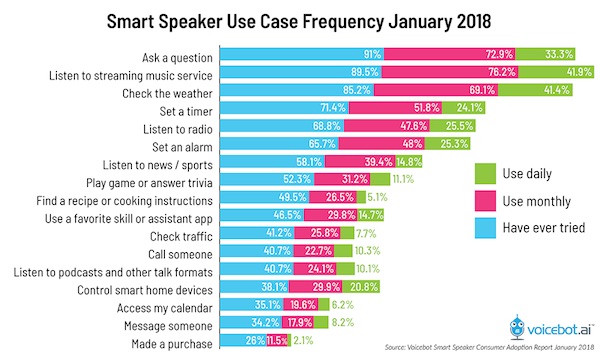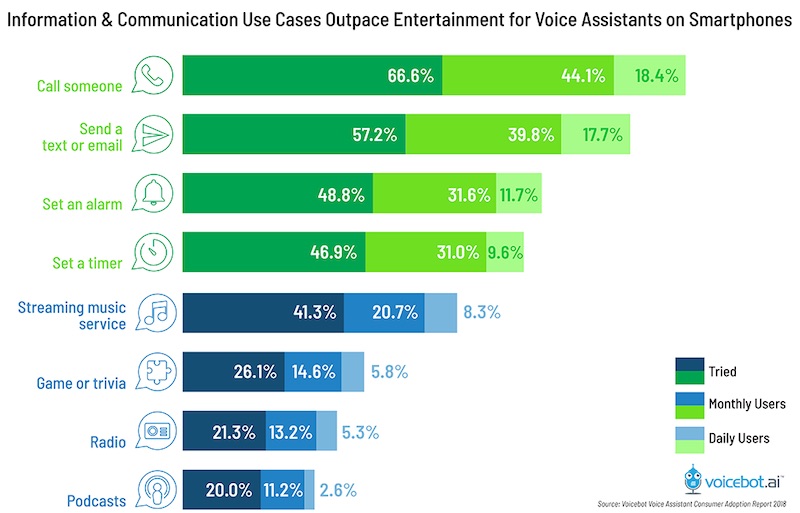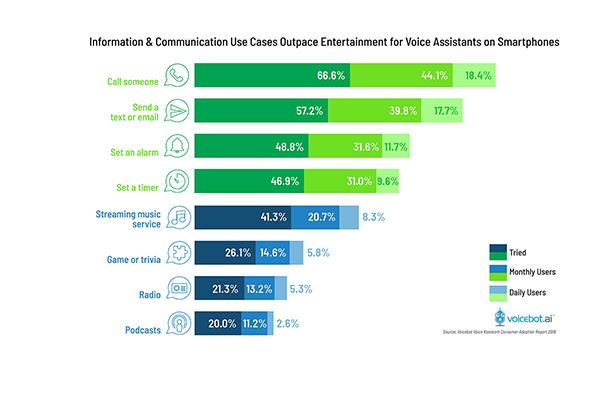Information and Communication Tasks Beat Out Entertainment for Voice Assistant Use Cases on Smartphones
Voicbot’s Voice Assistant Consumer Adoption Report 2018 developed in collaboration with PullString and RAIN Agency is revealing in how it creates a clear contrast between voice assistant use on smartphones and smart speakers. We know from earlier studies that listening to streaming music, the radio and news all fall in the top seven most common smart speaker use cases and music listening tops the list for frequency of use. Communications tasks fall near the bottom of the frequency scale.

By contrast, voice assistant use case frequency on smartphones is nearly inverted. The most popular use cases are information access followed closely by communication tasks such as initiating a phone call or sending a text message. Near the bottom are radio and podcast listening while accessing streaming music services is still in the bottom half.

Voice Assistant Use Case Frequency Reflects Context, Availability, and Expectations
The dichotomy reflects differences in context, availability, and expectations associated with different surfaces. First, voice assistant use on smartphones competes with manual interaction for all activities. And, the core context of smartphones is often productivity and communications while on the go. These are lean-in experiences. Smart speakers occupy a different space and different times of the day. Users are in one place and typically in situations where they are most interested in entertainment or information. These are typically lean-back experiences.
There is also the issue of availability. Because voice assistants on smartphones are not fully integrated into most apps, you cannot perform many of the key functions required for accessing media. These were some of the first features added to smart speakers. Growing availability of entertainment access through voice assistants on smartphones may change consumer behavior. However, it is important to note there are still many differences in context for smartphone use cases that will not change.
Then there are expectations. Consumers have not typically thought of smart speakers as communication devices. Similarly, entertainment use cases were not available when the first smartphone-based voice assistants arrived. As a result, users don’t expect those features and therefore making them a habit requires a shift in expectations. Greg Hedges, VP of Emerging Experiences at RAIN Agency added:
It’s clear that voice is not just ‘skills’ or ‘assistants’ — it’s a way that people are choosing to query and command the world around them for efficiency, knowledge, entertainment and more.
And, those choices are influenced by where they are, what they are doing and what device they are using. You can conclude from these data that voice assistant usage is both context and surface dependent. Over time we should expect to see some convergence, but in the near term optimizing experiences will need to adjust to current consumer behavior.
Follow @bretkinsella Follow @voicebotai
Apple Siri Continues to Lead in Voice Assistant Usage on Smartphones









